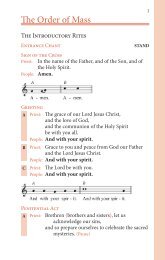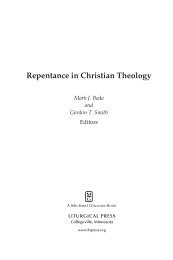“Fritz West, himself a methodological master of ... - Liturgical Press
“Fritz West, himself a methodological master of ... - Liturgical Press
“Fritz West, himself a methodological master of ... - Liturgical Press
You also want an ePaper? Increase the reach of your titles
YUMPU automatically turns print PDFs into web optimized ePapers that Google loves.
the Roman Rite in the <strong>West</strong> and the Byzantine Rite in the East. 55 At the<br />
same time that these rites had in themselves become uniform, however,<br />
they had also become distinct from one another. Their differences<br />
stemmed from how language and culture had shaped them (chapter<br />
11), 56 to what degree they embraced change or valued continuity<br />
(chapter 12), how they managed the pastoral question <strong>of</strong> comprehensibility<br />
(chapter 13), and their attitude—prior the ninth century—toward<br />
the liturgical embellishment <strong>of</strong> poetry (chapter 14). 57 Baumstark counts<br />
it significant that the imperial rites became firm in form in the very<br />
same century that they accepted challenges <strong>of</strong> evangelism. For in the<br />
ninth century both embraced evangelical missions toward the north:<br />
the Latin Church among the Scandinavians and the western Slavs,<br />
the Greek Church among the eastern Slavs. 58 In this work the imperial<br />
rites encountered cultures and languages different from their own.<br />
Having already been firmly formed, however, they had the confidence<br />
to project their imperial cultures into alien worlds to the north.<br />
At this point another organic process emerged—malformation, with<br />
two aspects: (1) the clear lines <strong>of</strong> the classical liturgy became blurred,<br />
and (2) the “natural” processes <strong>of</strong> the liturgical organism were compromised.<br />
59 The first aspect came to pass with the rampant growth <strong>of</strong><br />
55 Baumstark, On the Historical Development, pp. 128–29. The Byzantine<br />
Rite is a blend <strong>of</strong> the old Constantinopolitan Rite and the Jerusalem Rite, the<br />
Roman Rite a blend <strong>of</strong> the old Roman and the Frankish rites.<br />
56 For Baumstark, cultural traits can be distinctive enough to serve as criteria<br />
for categorizing liturgical texts. For example, ibid., pp. 69–70.<br />
57 While the period for the “Formation <strong>of</strong> Rites: Contrasts” is generally the<br />
same as that for “Formation <strong>of</strong> Rites: Similarities” (313–842/43), there are<br />
some differences. Notably, “Language and Nation” (chap. 11) impacted the<br />
liturgy from its first days and continues do so on through its history. The characteristics<br />
<strong>of</strong> “Development, Persistence, and Hardening” are set in this period<br />
but not limited to it. Finally, chap. 14, “The Ivy <strong>of</strong> Poetry” pertains both to the<br />
“Formation <strong>of</strong> Rites: Contrasts” and “Malformation.” In dealing with poetry<br />
prior to 842/43 (an approximate date), Baumstark describes how the East and<br />
the <strong>West</strong> contrasted sharply in their attitude toward liturgical poetry. Following<br />
that time, however, liturgical poetry overwhelmed and suffocated venerable<br />
liturgical forms in both East and <strong>West</strong> (see below).<br />
58 Ibid., pp. 128–29.<br />
59 The period <strong>of</strong> “malformation” needs to be qualified as well. The liturgy<br />
began to be overgrown by poetry and prayers approximately in the ninth century,<br />
but the terminus ad quem <strong>of</strong> this process is different in the <strong>West</strong> and<br />
20






